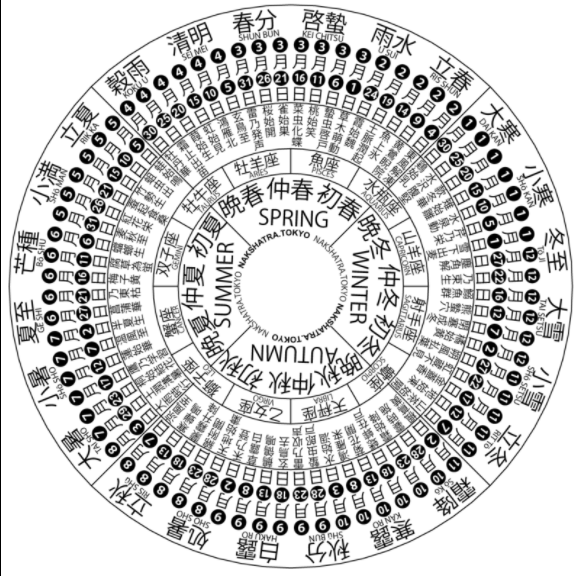What are the 24 solar terms?
The 24 solar terms were originally created by Chinese farmers in ancient times to help guide agricultural and farming activities. Each solar term was assigned to a period of the sun's movement along the ecliptic plane - the orbit of the Earth traveling around the sun. This solar term allocations also takes into account the longest and the shortest days of the year, as well as the two days of the year when the length of the day is the same as the night.
The development of the solar terms is another example of how the ancient Chinese divided time. In 2016, Twenty-Four Solar Terms was inscribed on the Representative List of the Intangible Cultural Heritage of Humanity by UNESCO.
Therefore, the four most important days that reflect changes of the season are:
- Spring Equinox
- Summer Solstice
- Autumn Equinox
- Winter Solstice

What are the solar terms of 2020 and what do they mean? (with Chinese translations)
- (2020) February 4 - Chinese New Year: "立春" (lì chūn, the Beginning of Spring), "立" means the beginning of all things on earth. "立春," then, suggests the start of the spring season
- February 19 - "雨水" (yú shuǐ, Rain Water) suggests the coming of more raining time
- March 5 - "惊蛰" (jīng zhé, the Waking of Insects), "蛰" means "deeply buried." Animals, usually insects deep in the earth for winter-sleep, are called "入蛰" (rù zhé). That animals come out from the earth the next spring is believed by the ancients to be woken up by the spring thunder. Thus the time is called “惊蛰,” the start of thunder
- March 20 - Spring Equinox "春分" (chūn fēn, the Spring Equinox) implies the equal length of daytime and nighttime (日夜平分, rì yè píng fēn). It also means that the spring season has been split into two parts
- April 4 - Important Grave Sweeping Festival "清明" (qīng míng, Pure Brightness) the weather is getting warmer, grass and plants are turning green, a picture of new life, instead of the scene of dried and yellow grass and plants in cold winter, is starting.
- April 19 - "谷雨" (gú yǔ, Grain Rain), tells that rainfall is increasing. Rainwater helps the grain grow. Ancient Chinese would say "雨生百谷" (yǔ shēng bǎi gǔ, rainwater helps promote the growth of hundreds of grain).
- May 5 - "立夏" (lì xià, the Beginning of Summer) means the end of Spring and the start of Summer
- May 20 -"小满" (xiǎo mǎn, Lesser Fullness of Grain) implies that plant seeds (fruits) are getting full but are not ripening yet
- June 5 -"芒种" (máng zhǒng, Grain in Beard) means that plants with beard-like wheat or barley are ripening and are ready for harvesting
- June 21 - Summer Solstice "夏至" (xià zhì, the Summer Solstice) means that hot summer is coming and the daytime of that day is the longest in the year
- July 6 - "小暑" (xiǎo shǔ, lesser Heat) means the days are getting hotter and 暑 literally translates to heat
- July 22 - "大暑" (dà shǔ, Greater Heat) is around the hottest day of the year
- August 7 -"立秋" (lì qiū, the Beginning of Autumn) means the end of summer is coming and the start of autumn
- August 22 - "处暑" (chú shǔ, the End of Heat) implies that the hot summer is coming to an end because 处 means end
- September 7 - "白露" (bái lù, White Dew) represents a time when the white dew condensed during nighttime when the temperature gets lower start appearing.
- September 22 - Autumn Equinox "秋分" (qiū fēn, the Autumn Equinox) implies the equal length of daytime and nighttime. It also means that Autumn, already been split into two parts, lies between “立秋” and “立冬.”
- October 8 -"寒露" (hán lù, Cold Dew) means that temperature is getting lower and more dew appears.
- October 23 -"霜降" (shuāng jiàng, Frost’s Descent), , implies the emergence of white frost due to the on-the-increase cold weather.
- November 7 - "立冬" (lì dōng, the Beginning of Winter) which means the end of Autumn and the start of winter
- November 22 - "小雪" (xiǎo xuě, Lesser Snow) which translates to mean the beginning of small snowfall because of the cold weather
- December 7 - "大雪" (dà xuě, Greater Snow) means great snow and more accumulated snow on the ground can be easily seen
- December 21 - Winter Solstice "冬至" (dōng zhì, the Winter Solstice) implies the arrival of the coldest time in winter. The term also tells that daytime on that day is the shortest in the year
- (2021) January 5 -"小寒" (xiǎo hán, Lesser Cold) suggests this is the start of the coldest season in a year
- (2021) January 20 -"大寒" (dà hán, Greater Cold) means this is the coldest time of the year

